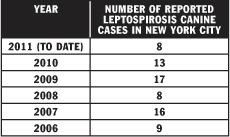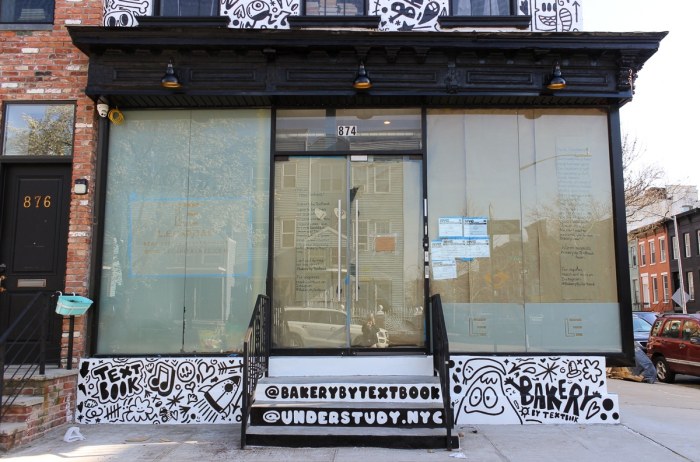By BETSY KIM
“She looked like she had been rolled in curry,” said East Village resident Traci Schiffer, describing the jaundiced skin and eyes of her Boston Terrier, which was diagnosed with leptospirosis.
While Schiffer was out of town, her mother on Long Island was dog-sitting, but phoned, worried because the dog was not eating.
“And Fenway never turns food down,” said Schiffer of her pooch. “I got home just in time. She came to see me and could barely move. I put her in the car, where she proceeded to throw up blood. I handed her over to the vet and was told she was a ‘very sick dog.’”
After extensive treatment and $7,000 in veterinary treatment, Fenway survived.
This incident occurred in July 2009, but Garrett Rosso, volunteer manager of the Tompkins Square Park dog run, believes the disease, often called “lepto” for short, is on the rise. Rosso owns and runs Village Dogworks, an obedience and behavioral dog-training company. He personally knows of at least five dogs that contracted the disease in the last two years.
Another East Village dog owner, who asked to remain anonymous for reasons unrelated to this article, said her 3-year-old toy poodle, Boris, caught lepto in April 2011. A vet initially misdiagnosed him as having a stomach problem. However, two days later, the owner took the dog to an animal hospital. After tests, antibiotics and a blood transfusion, in one week Boris died from kidney failure, in what his owner called a “terrible, hideous death.”
At one point, the owner was told the poodle had an 80 percent chance of survival, so approved medical procedures that ended up totaling $12,000.
According to the Centers for Disease Control and Prevention, leptospirosis is a bacterial disease that affects humans and animals. Without treatment, the disease can lead to kidney damage, meningitis (inflammation of the membrane around the brain and spinal cord), liver failure, respiratory distress and even death. Symptoms include fever, chills, headache, muscle aches, vomiting, diarrhea, abdominal pain, jaundice (yellowing of skin and eyes), rash and red eyes. However, some infected people don’t experience any of these symptoms.
C.D.C. lists rodents and dogs as animals that commonly develop or spread the disease. Lepto is most often spread by the urine and bodily fluids of the infected animals that are left in water or soil.
Rosso worries that without stronger rat control, lepto could easily spread in Tompkins Square Park. He pointed out numerous, large holes, where rats have burrowed to live beneath the ground, in the gardens and under the dog runs. Rats come out at night, drink from the puddles and urinate in the puddles and grass.
“In the morning, the kids come out to play and they are digging in the sand with the dogs, where the rats have peed,” Rosso said. Every day volunteers fill up the rat holes, but rats invariably return to their extensive network of underground nests.
Philip Abramson, a Parks Department spokesman, said he has received no complaints about dogs contracting lepto at the East Village greensward, and could not comment on the disease.
Sally Slavinski, assistant director of the zoonic influenza and vector-borne disease unit at the city’s Department of Health, noted the city conducts canine and human leptospirosis surveillance to help identify clusters, or “foci of activity,” of the disease. Slavinski said that from the city’s limited surveillance data, she does not see evidence that the disease is on the rise at this point.
Slavinski did not downplay the severity of the disease, saying it is the number one bacterial zoonic (transmissible from animals to people) disease in the world. However, she said, the disease is more prevalent in tropical areas and is rare in New York City. C.D.C. health specialist Christopher Cox said an estimated 100 to 200 human leptospirosis cases are identified annually in the U.S.
Chanel Caraway, a Health Department spokesperson, said one to three human cases of lepto are reported in New York City each year; about one-third of the cases are travel associated. She noted that last year, of the three reported cases, two of the people acquired the infection while traveling to a tropical region. In 2010 and 2011, none of the reported human cases involved children.
Slavinski said the department’s data does not represent every case in New York City. Although the health code requires veterinarians to report leptospirosis, vets are not prosecuted for failure to report the disease.
On April 28, 2011, the department issued a veterinary alert, “Summary of Canine Leptospirosis Surveillance in New York City 2009-2010,” which is available online at https://www.nyc.gov/html/doh/downloads/pdf/zoo/11vet02.pdf .
The report noted the numbers of canine lepto cases and the most common strains of the bacteria infecting the animals. It pointed out that risk factors for infection included observing rodents, raccoons or other wildlife and exposure to puddles of water. The report stated no clusters or outbreaks of lepto were detected and that it appears to be rare in New York City dogs.
The report further noted transmission from dogs to humans is rare and has not yet been reported in New York City.
Pet owners whose dogs contracted lepto, emphasize the severity of the disease. East Village resident Amy Tiscornia’s pit bull mix, Bird, became gravely ill with lepto in May 2009. She described how her playful, lively, 3-year-old, white pit mix quickly grew jaundiced and lethargic with a fever. With an infected liver, Bird went into an I.C.U. and remained at an animal hospital for five days. Tiscornia, who worked as a waitress at the time, struggled to pay the $4,000 bill.
“It was so scary,” she said, emphasizing her dog did nothing unusual to contract the disease. “All Bird did was go for walks and play ball.”
The lepto bacteria dies in dry conditions, so outbreaks tend to occur in warm, moist environments. The April 2011 veterinary alert stated most cases are reported between May and November, with the 2009 and 2010 cases peaking in October and November. The majority of dogs that contracted lepto were exposed to rodents.
In Tompkins Square Park, rats exist in close proximity to the park’s human and canine visitors. At around 4 p.m. one day as this reporter was interviewing Rosso, three rats were observed near the Seventh St. playground, with one scurrying across the walkway. In late August, one of the dogs that Rosso was walking chased and caught a rat, which Rosso had to knock from the canine’s mouth.
“It’s bad,” said Scott Hawley, who brings his boxer to Tompkins Square each day. “Around dusk, I’d say at 7 or 8 o’clock, you can no longer walk through the park because of the rats. They are everywhere. They freak the dogs out because the dogs chase them.”
In addition to trying to eliminate rats’ food sources, Parks is taking various other measures in response to community concerns. Abramson in an e-mail acknowledged that Parks is not placing rat poison in Tompkins Square Park out of concern for the resident red-tailed hawk. However, the department replaced the garbage baskets with garbage drums to prevent rodents from getting inside them.
Abramson wrote that the department placed 20 mechanical rat traps in the affected area of the park and has removed ground cover that had sheltered rats. The Parks Department is cleaning weeds and low-growing shrubs, and applying woodchips to the garden beds. It is also placing metal mesh under the dirt of the planting beds to block the rats from burrowing.
“We have colonies of rats, burrowing under the dog park, surrounding the Parks office and in every garden area,” Rosso said.
“We don’t need a simple band-aid fix in one area, which is just designed to pay lip service to the parents’ very real concerns.”
The owner of the poodle who died in April from lepto refuses to take her new dog to Tompkins Square Park.
“We have to take care of these rats. It’s disgusting,” she said, “It’s 2011 and they can’t deal with rats? It’s not 1811. Where there are rats, there’s disease. We have all these rats in the park. How can that be acceptable? It’s just not acceptable. It’s just not.”


















